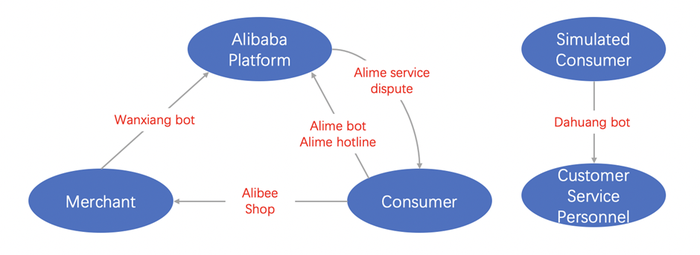Case Study: How Alibaba Uses AI Chatbots to Serve a Billion Customers
Alibaba uses AI chatbots to handle over two million daily customer service sessions and over 10 million lines of daily chats
February 14, 2024

Reprinted with permission from the special issue on AI and customer engagement in Management and Business Review. Original title: The Alibaba Challenge: How to Effectively Engage with A Billion Customers
Alibaba Group, China’s largest e-commerce company and one of the world’s biggest companies, has nearly one billion annual active Chinese consumers who make hundreds of millions of transactions daily using its Taobao e-commerce platform.
During Alibaba’s busiest shopping period in 2021 − Taobao’s Double 11 shopping festival − its platforms facilitated 540 billion RMB (US $85 billion) in transactions over a two-day period. The sheer number of customer interactions in Taobao transactions makes it difficult for Alibaba to proactively engage with customers when needed.
Further, Alibaba needs to resolve several million customer service queries each day. The queries can come from end-user consumers or business merchants in Alibaba’s two-sided platform. Consumers may have questions about the Alibaba platforms or were unsatisfied with products they purchased from merchants on the platform. Merchants could have questions about end-user consumers or also about the platforms.
Taken together, Alibaba faces resource restrictions that limit its ability to engage with customers solely by human service interactions. Since 2015, Alibaba’s response has been to implement artificial intelligence (AI) chatbots, supplemented by human service interactions, to both proactively and reactively engage with its customers.
Today, Alibaba uses AI chatbots to handle customer engagements for more than two million daily sessions and over 10 million lines of daily conversations on Taobao’s two-sided platform, representing about 75% of Alibaba’s online and 40% of phone hotline consultations.
Not only has the use of AI chatbots raised customer satisfaction by 25%, based on initial results, it has saved the company more than one billion RMB annually (~US $150 million) by employing AI instead of human contact center agents.
Alibaba’s AI chatbots
Alibaba employs five AI chatbots to cater to the heterogenous demands from customers on Taobao’s two-sided platform.
The Wanxiang-bot is designed to assist merchants on the Taobao platform, such as for resolving questions on the platform’s rules, activities, and service issues.
The Alibee Shop bot is designed to assist merchants with end-user consumer interactions on Taobao, such as for service issues or any direct merchant-to-consumer engagements.
The Alime bot is aimed at helping the end-user consumer. It is employed in online and phone hotline channels and relies on a rich set of interactive user interface components that can provide text dialogues, cards, graphics, videos and other conversational interactions between the robots and consumers.
Alime-bot also possesses duplex voice dialogue capabilities and a targeted voice user interface to serve users who prefer to consult through telephone channels.

Alibaba’s Five AI-bots Employed for Customer Service Engagements (arrow direction indicates which party initiates the conversations)
The AI-bot complements Alime in that it proactively engages with end-user consumers and acts as an intermediary during service disputes with business merchants. The AI-bot’s underlying algorithms use transaction and conversational information to evaluate service disputes and make automated judgments. The AI-bot then calls end-user consumers to discuss the dispute decision. If consumers are satisfied with the AI-bot’s decision, the case is closed; if not, the AI-bot helps consumers fill out appeal forms for case resolution by a human evaluator.
The Dahuang-bot helps train customer service personnel by simulating a larger number and more diverse set of consumer and merchant encounters compared to a non-AI-based training system.
Implementation challenges and solutions
The first challenge Alibaba faced was organizational hesitancy: Engineers and the leadership team were wary of AI’s ability to positively engage with and resolve consumer and business merchant queries. To overcome this hesitancy, the firm implemented a fast-fail strategy that continually tested AI vs. human responses in small-scale real-world experiments.
The pilot proved that the AI chatbots outperformed their human counterparts by delivering superior end-user customer satisfaction scores as well as improved business merchants’ first-contact resolution scores. Those results led to full Alibaba organizational buy-in to implementing AI customer engagement services.
The second challenge involved two technical issues. Many initial customer queries involved a user-intent classification problem: Queries were stated similarly but had different underlying intents. For example, “I need help with my order” can mean needing help with tracking an order, getting a refund, or many other intents. In addition, many customer queries involved a long-tail problem: extremely low probabilities for certain types of queries. Since niche topics by nature have less data, queries about them tend to lead to less accurate chatbot answers – which lowers customer satisfaction.
To overcome the first technical problem, Alibaba developed an Extensible Multitask Learning paradigm using a Meta Lifelong Learning Framework that learned robust text representations across tasks and employed a Least Recently Used replacement policy to manage model deployment and memory resources. To overcome the latter problem, Alibaba implemented a multi-grained interactive matching network for few-shot text classification that leverages a dynamic routing algorithm in meta-learning to better adapt and generalize unseen classes while also providing more memory-based flexibility.
AI vs. human results
Overall, Alibaba’s AI-based customer satisfaction scores exceeded or matched human-based engagements in most product categories. Crucially, it provided customers much quicker responses and enabled Alibaba to engage with customers at all hours of the day.
Based on A/B testing results, Alibaba’s proactive AI-based intermediary dispute service resulted in a 25% increase in customer satisfaction in its first few weeks of operation from its previous non-AI-based dispute resolution procedure.
Alibaba’s training bot is assisting more than 1,500 customer service personnel daily. In addition, its training bot is reducing customer service personnel training time by more than 20%.
Finally, Alibaba has realized cost savings of over a billion RMB annually (~US $150 million) by employing AI over humans for service engagements.

Lessons learned and next steps
Alibaba employs its five AI-based chatbots in more than 80 Alibaba-related apps, such as Taobao, Xianyu, Fliggy, Hema, and Lazada. Initially, it took Alibaba developers one year to create the initial AI-bot. However, this process has become much more efficient, and it now takes Alibaba’s developers only one month to develop a new AI-bot for its platforms, although they have to continually improve the bot.
Alibaba has also learned that customers have accepted the chatbots and appreciate its role in resolving many, though not all, types of customer service queries. It has learned it is critical to constantly test the structure to see what types of help customers are willing to accept from AI-based chatbots.
A key lesson Alibaba learned was that, despite its chatbots’ success, AI cannot and should not completely replace human-based customer service engagements. But each should be deployed depending on the scenario that best suits their capabilities.
For example, for simple FAQ questions, AI can directly reply to users. However, for complex complaints and disputes, AI can replace manual labor-intensive tasks, such as collecting information on appeals and vouchers, and possibly making initial decisions, but humans will still need to review the AI-collected information − in addition to non-standard materials based on the collected information − to make final judgments.
Going-forward, Alibaba continually invests significant resources to make a seamless human-machine collaboration. For example, Alibaba’s AI-bots continuously monitor whether customers encounter obstacles and whether the AI-based service can understand and resolve customers’ queries.
Whenever appropriate, the AI-bot automatically transfers customers to human-based service agents and will then prompt and provide agents essential information to help continue the conversation without asking the customers to repeatedly describe the problem.
At the same time, the AI-based bot enhances customer interactions with human agents by providing data-based solutions, particular word phrasing recommendations, and issuing on-the-spot warnings to human agents if they behave improperly.
Finally, Alibaba believes that although technologically proficient AI natural language processing models and training data are important, establishing an organizational mindset offering customer-centric AI-based solutions that efficiently solves customer problems is more important than just implementing AI.
Hence, Alibaba is continuing to improve its AI-bots through hundreds of releases, iterations, and improvements over time, with the ultimate goal of solving customers’ problems in the most efficient and satisfying method possible, whether through AI or human-based service engagements.

About the Author(s)
You May Also Like




.jpg?width=700&auto=webp&quality=80&disable=upscale)
.jpg?width=300&auto=webp&quality=80&disable=upscale)
.jpg?width=300&auto=webp&quality=80&disable=upscale)
.jpg?width=300&auto=webp&quality=80&disable=upscale)
.jpg?width=300&auto=webp&quality=80&disable=upscale)
.jpg?width=300&auto=webp&quality=80&disable=upscale)